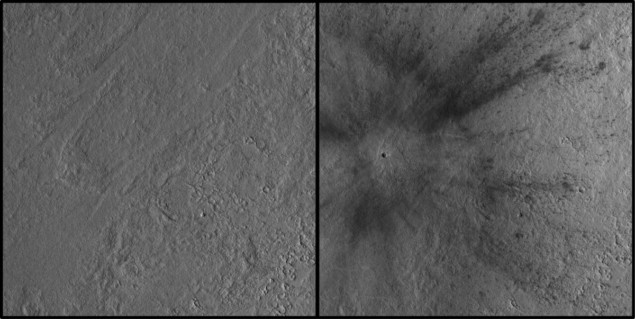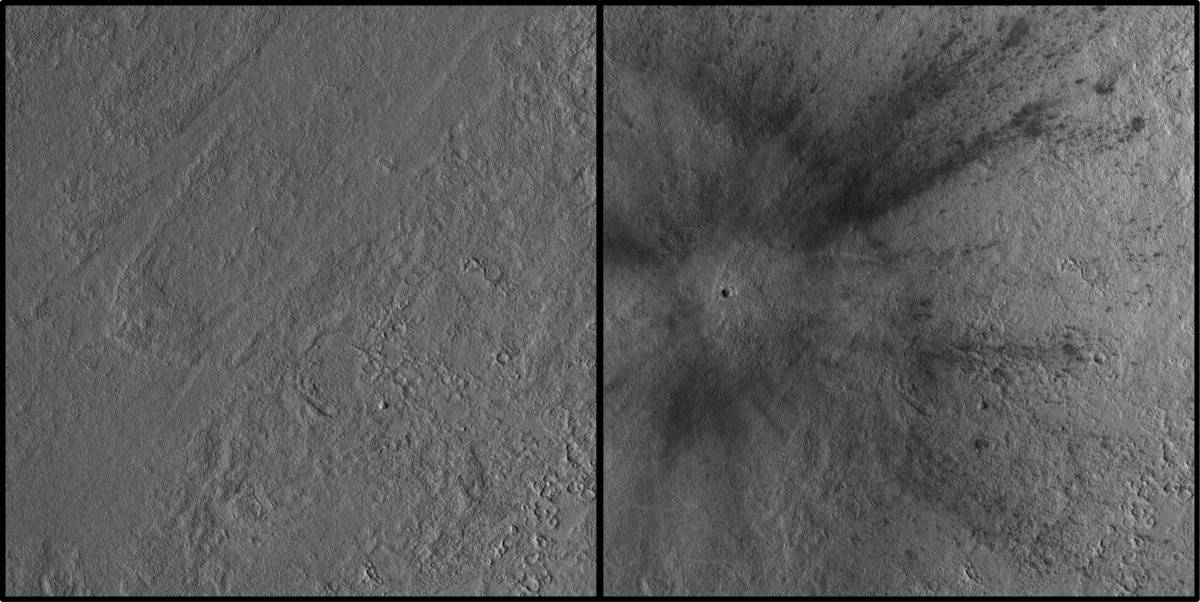
Two meteorite impacts on the Martian surface have given scientists a better understanding of the interior structure of the Red Planet. The impacts happened in 2021 and an international team of researchers has shown that surface seismic waves detected on Mars were caused by the impacts. A second, related study, examined the seismic waves in detail and concluded that the planet’s crust varies in density.
One impact crater is on the Amazonis Planitia, which is an extremely flat plain in the northern hemisphere of the Red Planet. The impact that made this feature occurred on 24 December 2021, according to the researchers. The second impact crater is in the Tempe Terra, which is a rugged region that is also in the northern hemisphere. This crater was created on 18 September 2021.
Much of what we know about the interior of the Earth comes from monitoring seismic waves as they travel through our planet. Waves that propagate near to the surface of a planet shed light on the planet’s crust and upper mantle, while body waves moving through the centre of a planet, tell us something about the deep interior. While NASA’s InSight seismic monitoring lander has detected body waves in Mars, these are the first surface waves to be observed.
Now, scientists have analysed these waves. One study was led by Liliya Posiolova of US-based Malin Space Science Systems and the other led by Doyeon Kim of Switzerland’s ETH Zurich and the University of Maryland in the US. Posiolova, Kim and several of their colleagues were involved in both studies.
Making links
Possiolova’s team made the link between the Amazonis and Tempe craters and seismic signals using satellite images of the Martian surface taken by NASA’s Mars Reconnaissance Orbiter (MRO). They describe their work in Science.
“At first we constrained [the Amazonis impact] to about five days in late December, but with further processing we managed to constrain it to a 25 hour time period centered roughly on December 24, 2021,” says Posiolova. That date jogged her memory, and she realized that InSight had recorded a seismic signal on that day.
Posiolova’s team quickly looked up the estimated epicenter of the 24 December event and realized that the Amazonis crater must have been the source of the seismic disturbance. Not resting on their laurels, the researchers looked into another seismic signal that was detected on 18 September and linked it to the Tempe Terra crater. As well making connections between meteoric impacts and seismic signals, the craters are the two largest that have been found by the MRO in its 16 years of operation.
Closer look
Meanwhile, Kim and colleagues took a much closer look at the seismic data, which he says was no mean feat. His team also reported its results in Science.
“The seismic data collected on Mars are much more difficult to analyze compared to those collected on Earth,” says Kim. “Because the sources of the two impacts are at the surface, they were effective at generating [and] propagating waves along the planet’s surface. Before the detection [and] identification of surface waves on Mars, our understanding of the Martian crust has been limited to what’s beneath the InSight landing site.”
One important discovery made by the team is that north of Mars’ equatorial dichotomy, the crust has a uniform structure and depth. They also found that the crust there has a high shear velocity of about 3.2 km/s. This implies that this region has a higher crustal density than what has been observed directly below InSight, which is near the equator.
Impressive accomplishment
This addition to our knowledge of what lies below Mars is an impressive accomplishment, given that there is just one seismic station on the planet. Indeed, the research establishes that spatial information about the crust can be obtained from just one seismic monitor.

Simulations show that asteroid impacts would destroy evidence for relic shorelines on Mars
The research also sheds further light on how meteorites impact Mars. This is expected to be much different than impacts on Earth, where our planet’s much thicker atmosphere tends to act as a protective shield that burns up smaller meteorites.
Posiolova points out that this is the first time we have data documenting large meteorite impacts, including temporal records from InSight’s Seismic Experiment for Interior Structure (SEIS) instrument and spatial records from the MRO imagers. This can tell scientists a lot about how meteorite impact energy is distributed into the Martian ground and atmosphere.
While our current understanding of Mars’ crust and upper mantle is reasonably good, Posiolova says that the planet’s deep mantle structure is still “not yet fully understood.” Seismic data from meteoric impacts could shed further light on this shady part of the planet’s interior.
